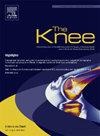额面截骨角度对内侧开放式楔形高胫骨截骨术外侧皮质骨折的影响
IF 1.6
4区 医学
Q3 ORTHOPEDICS
引用次数: 0
摘要
背景:精确的胫骨高位截骨术至关重要,尤其是对于患有内侧室关节炎的中年人,其目的是防止外侧皮质骨折等并发症。本研究探讨了在内侧开刃高胫骨截骨术中,额平面截骨倾斜度对外侧皮质骨折的影响:通过有限元分析,对胫骨模型进行了角度为 10°、13°、16°、19°和 22°的截骨,形成了五个模型。施加的力从 5 牛到 75 牛不等,记录外侧铰链处的骨应力(兆帕)、沿截骨线的角度变化(°)和间隙距离(毫米):结果:在相同作用力下,前倾角越大的模型间隙距离越大。例如,在 5 牛顿力的作用下,10°倾角模型的矫正角度为 0.28°,间隙为 1.43 毫米,而 22°倾角模型的矫正角度为 0.35°,间隙为 1.37 毫米。在 75 N 的力作用下,10° 模型的矫正角度为 10.81°,间隙为 14.02 mm,而 22° 模型的矫正角度为 16.86°,间隙为 19.31 mm:结论:当间隙距离相同时,截骨起点与关节的距离对外侧皮质的最终应力影响不大。然而,在需要更高程度矫正的病例中,我们可以说,外科医生可以通过将截骨起点保持在距关节线更远的位置,以更小的阻力达到矫正效果。本文章由计算机程序翻译,如有差异,请以英文原文为准。
The effect of frontal plane osteotomy angle on lateral cortex fracture in medial open wedge high tibial osteotomy procedure
Background
Precise high tibial osteotomy is crucial, especially for middle-aged individuals with medial compartment arthritis, aiming to prevent complications like lateral cortex fractures. This study explores how frontal plane osteotomy inclination impacts lateral cortex fractures during medial open-wedge high tibial osteotomy.
Methods
Using finite element analysis, tibia models underwent osteotomies at angles of 10°, 13°, 16°, 19°, and 22°, forming five models. Forces from 5 N to 75 N were applied incrementally, recording bone stresses (MPa) at the lateral hinge, angle changes (°) along the osteotomy line, and gap distances (mm).
Results
Models with higher frontal inclination showed increased gap distances under identical forces. For instance, at 5 N force, the 10° inclination model displayed a correction angle of 0.28° and a 1.43 mm gap, while the 22° model had a correction angle of 0.35° and a 1.37 mm gap. Under 75 N force, the 10° model had a correction angle of 10.81° and a 14.02 mm gap, while the 22° model had a correction angle of 16.86° and a 19.31 mm gap.
Conclusion
The osteotomy starting point’s distance from the joint doesn’t significantly impact final stress on the lateral cortex when the same gap distance is achieved. However, in cases requiring a higher degree of correction, we can say that the surgeon can achieve the result with less resistance by keeping the osteotomy starting point more distal to the joint line.
求助全文
通过发布文献求助,成功后即可免费获取论文全文。
去求助
来源期刊

Knee
医学-外科
CiteScore
3.80
自引率
5.30%
发文量
171
审稿时长
6 months
期刊介绍:
The Knee is an international journal publishing studies on the clinical treatment and fundamental biomechanical characteristics of this joint. The aim of the journal is to provide a vehicle relevant to surgeons, biomedical engineers, imaging specialists, materials scientists, rehabilitation personnel and all those with an interest in the knee.
The topics covered include, but are not limited to:
• Anatomy, physiology, morphology and biochemistry;
• Biomechanical studies;
• Advances in the development of prosthetic, orthotic and augmentation devices;
• Imaging and diagnostic techniques;
• Pathology;
• Trauma;
• Surgery;
• Rehabilitation.
 求助内容:
求助内容: 应助结果提醒方式:
应助结果提醒方式:


